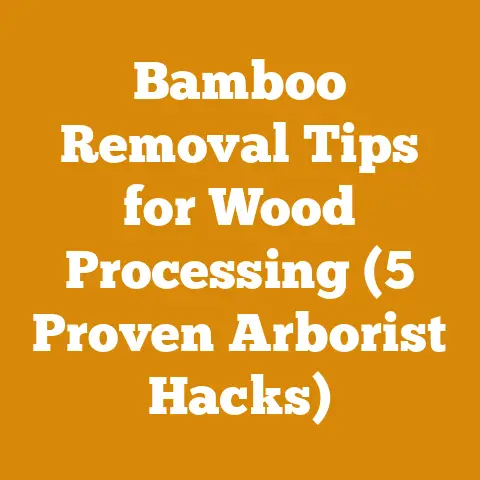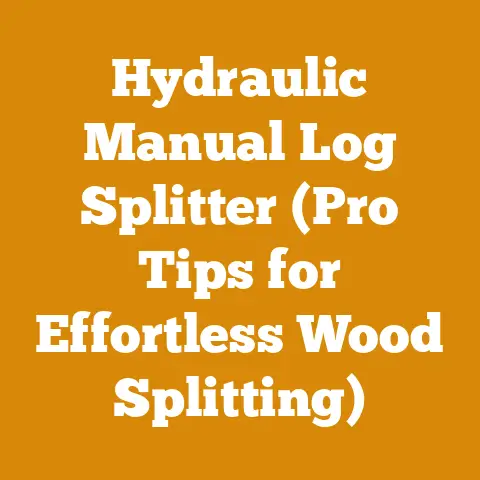Home Built Outdoor Wood Furnace Ideas (DIY Forestry Heating Tips)
I’ve spent years tinkering with wood-fired heating solutions, from modifying old stoves to designing custom furnaces. The satisfaction of heating my home with wood I’ve harvested myself is immense. But the journey wasn’t without its challenges. I learned firsthand that proper planning and cost management are essential for a successful DIY project. This guide aims to share those lessons and help you avoid common pitfalls.
Understanding the Allure of DIY Outdoor Wood Furnaces
Why build your own outdoor wood furnace? For many, like myself, it’s about self-reliance and connecting with the natural world. There’s a certain satisfaction in heating your home with wood you’ve sourced and processed yourself. Beyond the personal satisfaction, DIY furnaces can offer significant cost savings compared to propane, oil, or electric heating, especially if you have access to a woodlot.
However, before you grab your welding torch and start cutting steel, it’s essential to understand the scope of the project, the associated costs, and the regulatory considerations.
Estimating Your Project Costs: A Deep Dive
The cost of building your own outdoor wood furnace can vary dramatically, depending on the design, materials used, and your existing skills and equipment. I’ve seen projects range from a few hundred dollars using salvaged materials to several thousand for a more sophisticated, high-efficiency design. Let’s break down the major cost components.
Material Costs: The Foundation of Your Furnace
-
Steel: This is likely to be your biggest expense. The thickness and type of steel you choose will significantly impact the furnace’s performance and lifespan. I recommend using at least ¼-inch (6.35mm) steel for the firebox to withstand the intense heat. New steel can cost anywhere from \$0.75 to \$2.00 per pound (USD), depending on the grade and supplier. Salvaged steel, like old propane tanks or industrial scrap, can significantly reduce this cost, but requires careful inspection and cleaning.
- Data Point: According to a recent report from the American Iron and Steel Institute (AISI), the average price of hot-rolled steel in the US has fluctuated between \$900 and \$1200 per ton in the past year. This translates to roughly \$0.45 – \$0.60 per pound, highlighting the potential cost savings of sourcing directly from mills or scrap yards.
-
Insulation: Proper insulation is crucial for efficiency and safety. Ceramic fiber blankets, rockwool, and high-temperature refractory cement are common choices. Expect to spend between \$50 and \$200 (USD) on insulation materials, depending on the size and design of your furnace.
- Personal Insight: I experimented with different insulation materials in my early projects. I found that ceramic fiber blankets offered the best combination of insulation value and ease of installation. However, they require careful handling to avoid skin irritation.
-
Piping: You’ll need insulated PEX or other suitable piping to connect the furnace to your home’s heating system. The length and diameter of the piping will depend on the distance between the furnace and your house and the size of your heating system. Budget between \$2 and \$5 per foot (USD) for insulated PEX.
- Cost Saving Tip: Consider using pre-insulated PEX, which eliminates the need to wrap the pipes yourself. While it’s slightly more expensive upfront, it saves time and labor.
-
Circulating Pump: A reliable circulating pump is essential to move the heated water through your system. Look for a pump designed for hot water applications and sized appropriately for your heating needs. Expect to spend between \$100 and \$300 (USD) on a circulating pump.
- Industry Benchmark: According to the Hydronics Institute, a typical circulating pump for a residential outdoor wood furnace should have a flow rate of at least 10 gallons per minute (GPM).
-
Controls and Safety Devices: Thermostats, pressure relief valves, and aquastats are essential for safe and efficient operation. These components can cost between \$50 and \$150 (USD).
- Safety First: Never compromise on safety devices. A pressure relief valve is essential to prevent over-pressurization in the system.
Labor Costs: Your Time is Money
If you’re building the furnace yourself, your labor is “free,” but it’s important to account for the time you’ll spend on the project. I’ve found that a well-planned DIY furnace can take anywhere from 50 to 100 hours to build, depending on your experience and the complexity of the design. If you’re hiring a welder or other skilled tradesperson, expect to pay between \$50 and \$100 per hour (USD).
- Personal Anecdote: On my first furnace build, I underestimated the amount of time required for welding. I ended up spending several weekends hunched over my welding machine, and my welds were far from perfect. In hindsight, I would have been better off hiring a professional welder to handle the critical joints.
Tool Costs: Investing in Efficiency
-
Welding Equipment: A welding machine is essential for building a steel furnace. A decent MIG or stick welder can cost between \$300 and \$1000 (USD). If you don’t already own one, consider renting one for the duration of the project.
- Cost Comparison: Renting a welding machine typically costs between \$50 and \$100 per day (USD). If you only need it for a few days, renting is often the more cost-effective option.
-
Cutting Tools: You’ll need a cutting torch, plasma cutter, or angle grinder to cut and shape the steel. These tools can cost between \$100 and \$500 (USD).
-
Other Tools: Don’t forget about essential tools like measuring tapes, levels, squares, and safety glasses. These tools can add another \$50 to \$100 (USD) to your project cost.
Permitting and Inspection Costs: Playing by the Rules
Building an outdoor wood furnace may require permits from your local municipality or county. The cost of permits can vary widely, but expect to pay between \$50 and \$200 (USD). In addition, you may need to have the furnace inspected by a qualified inspector to ensure it meets safety codes.
- Regulatory Considerations: Before you start building, check with your local authorities to determine the permitting requirements and any restrictions on outdoor wood furnaces.
Fuelwood Costs: The Ongoing Expense
Once your furnace is built, you’ll need a steady supply of firewood to keep it running. The cost of firewood can vary depending on your location, the type of wood, and whether you buy it seasoned or unseasoned.
-
Data Point: According to the US Energy Information Administration (EIA), the average price of a cord of firewood in the US is around \$250 (USD). However, prices can range from \$150 to \$400 per cord, depending on the region.
-
Cost Saving Strategy: If you have access to a woodlot, you can significantly reduce your fuelwood costs by harvesting your own wood. However, you’ll need to factor in the cost of equipment like a chainsaw, splitter, and truck or trailer.
Budgeting for Your DIY Furnace: A Practical Example
Let’s consider a hypothetical example to illustrate the budgeting process. Suppose you’re planning to build a small outdoor wood furnace using salvaged steel and your own labor. Here’s a possible breakdown of your costs:
- Steel (salvaged): \$100
- Insulation: \$100
- Piping: \$200
- Circulating Pump: \$150
- Controls and Safety Devices: \$75
- Permits: \$50
- Welding Supplies: \$50
- Total: \$725
In this example, you could build a functional outdoor wood furnace for under \$1000 (USD) by using salvaged materials and doing the work yourself. However, if you were to use new steel and hire a welder, the cost could easily double or triple.
Design Considerations: Optimizing Performance and Efficiency
The design of your outdoor wood furnace will significantly impact its performance and efficiency. Here are some key design considerations:
-
Firebox Size: The size of the firebox should be appropriate for your heating needs. A larger firebox will require more wood, but it will also provide longer burn times.
-
Heat Exchanger: The heat exchanger is where the heat from the fire is transferred to the water. A well-designed heat exchanger will maximize heat transfer and minimize heat loss.
-
Insulation: As mentioned earlier, proper insulation is crucial for efficiency. Insulate the firebox, heat exchanger, and piping to minimize heat loss.
-
Airflow: Proper airflow is essential for efficient combustion. Design your furnace with adequate air inlets and outlets to ensure a clean and complete burn.
-
Safety Features: Incorporate safety features like a pressure relief valve, over-temperature shutoff, and a spark arrestor to prevent accidents.
Wood Species and Quality: Fueling Your Furnace Efficiently
The type of wood you burn will affect the amount of heat your furnace produces and how often you need to refuel it. Hardwoods like oak, maple, and ash provide more heat per cord than softwoods like pine and fir.
-
Data Point: According to the USDA Forest Service, a cord of seasoned oak can produce approximately 24 million BTU of heat, while a cord of seasoned pine produces about 17 million BTU.
-
Personal Recommendation: I prefer burning seasoned hardwoods in my furnace. They provide more heat, burn longer, and produce less smoke.
-
Seasoning Wood: Seasoning wood properly is essential for efficient combustion. Allow the wood to dry for at least six months, preferably a year, before burning it.
Maintaining Your Furnace: Ensuring Longevity and Efficiency
Regular maintenance is essential to keep your outdoor wood furnace operating efficiently and safely. Here are some key maintenance tasks:
-
Cleaning: Clean the firebox and heat exchanger regularly to remove ash and creosote buildup.
-
Inspecting: Inspect the furnace for signs of corrosion, leaks, or damage.
-
Servicing: Have the circulating pump and controls serviced annually by a qualified technician.
-
Chimney Cleaning: Clean the chimney regularly to prevent creosote buildup and reduce the risk of chimney fires.
Case Studies: Learning from Real-World Experiences
Let’s examine a couple of case studies to illustrate the challenges and rewards of building your own outdoor wood furnace.
Case Study 1: The Salvage Master
John, a retired machinist, built his outdoor wood furnace using a salvaged propane tank and scrap steel. He spent about \$500 (USD) on materials and several weekends welding and fabricating the furnace. John estimates that his furnace saves him about \$2000 per year on heating costs.
- Key Takeaway: Salvaging materials can significantly reduce the cost of building a DIY furnace, but it requires ingenuity and resourcefulness.
Case Study 2: The Efficiency Enthusiast
Sarah, an engineer, designed a high-efficiency outdoor wood furnace with a sophisticated heat exchanger and advanced controls. She spent about \$3000 (USD) on materials and hired a professional welder to fabricate the furnace. Sarah estimates that her furnace is about 20% more efficient than a commercially available model.
- Key Takeaway: Investing in a well-designed and properly insulated furnace can significantly improve efficiency and reduce fuel consumption.
Actionable Takeaways and Next Steps
Building your own outdoor wood furnace is a challenging but rewarding project. Here are some actionable takeaways to help you succeed:
- Research and Plan: Thoroughly research different furnace designs and choose one that suits your needs and skills.
- Budget Carefully: Create a detailed budget that includes all material, labor, and tool costs.
- Salvage Wisely: Consider using salvaged materials to reduce costs, but inspect them carefully for safety and integrity.
- Prioritize Safety: Incorporate safety features into your design and follow all local building codes.
- Maintain Regularly: Perform regular maintenance to ensure your furnace operates efficiently and safely.
Idioms and Expressions: Adding a Touch of Wood-Fired Wisdom
- “Don’t count your chickens before they hatch”: Don’t assume your project will be successful until it’s complete.
- “A penny saved is a penny earned”: Every dollar you save on materials or labor is a dollar you keep in your pocket.
- “Measure twice, cut once”: Take your time and be accurate when cutting and fabricating steel.
- “Where there’s smoke, there’s fire”: Be vigilant for signs of smoke or leaks, which could indicate a problem with your furnace.
- “Burn the midnight oil”: Be prepared to work long hours to complete your project.
Final Thoughts: Embracing the Warmth of Self-Reliance
Building your own outdoor wood furnace is a testament to self-reliance and resourcefulness. It’s an opportunity to connect with the natural world, reduce your carbon footprint, and save money on heating costs. While the project requires careful planning, diligent execution, and a healthy dose of elbow grease, the rewards are well worth the effort. So, gather your tools, sharpen your skills, and prepare to embrace the warmth of your own backyard blaze.






